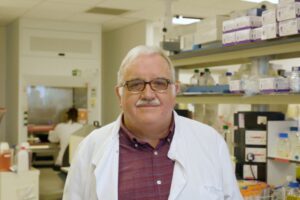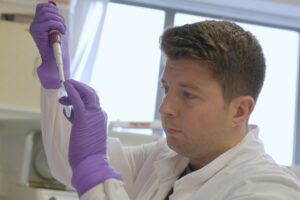Completely debilitating, isolating and misunderstood.
That’s how my friend Carey remembers the extreme sickness and nausea she experienced during pregnancy.
The condition is known as hyperemesis gravidarum (HG) or hyperemesis. It led to her being sick up to 40 times a day, for her entire pregnancy, and bedridden for the first seven months. She lost two stone, all whilst having to fight to be listened to, and for adequate care and intravenous fluid (IV) drips.
Carey says:
The vomiting was so severe I couldn’t even take a breath between each episode. My experience was incredibly traumatic, the hardest of my life, and to this day I have no idea how my baby and I survived. I was the lucky one in that my baby was born healthy and happy, but the trauma has left permanent scars.
Millions of lives affected worldwide
Pregnancy sickness is common. It affects up to 80% of pregnancies worldwide, to varying degrees of severity. Hyperemesis, the most extreme form, affects around 1% to 2% of pregnancies. This equates to millions of pregnancies around the world. It can destroy relationships and threaten the life of the fetus and the mother.
Professor Stephen O’Rahilly is a hormone researcher and Director of the Medical Research Council (MRC) Metabolic Diseases Unit at the University of Cambridge. He describes the phenomenal impact of the condition:
The nausea and vomiting experienced is severe and the same as symptoms experienced when people receive chemotherapy for cancer. So the trivialisation of it and calling it ‘morning sickness’ is just nonsense.
The tip of the iceberg is hyperemesis but there’s a gradation of symptoms. Our data from pregnant women show a significant number of days lost at work due to nausea. There are women living with social and economic misery for several months. They’re at risk of losing their jobs if they’re in the private sector, if they’re in vulnerable employment or the sole breadwinner in a single parent family. The economic and social impact is immense.

Professor Steve O’Rahilly. Credit: Jonathan Settle, University of Cambridge
Finding a cause
There’s no specific treatment for hyperemesis and until recently no known cause. But a recent Cambridge-led study found that the degree of pregnancy nausea and vomiting is directly related to a hormone produced by the baby growing in the womb.
This hormone is a protein known as growth differentiation factor 15 (GDF15). Made at low levels in all human tissues outside of pregnancy, tissues send GDF15 out into the bloodstream when responding to damage of any kind.
The study made two exciting findings, explains Steve, who led the collaboration:
Hyperemesis is due to the amount of GDF15 made by the fetus, which is sent into the mother’s bloodstream and acts on her brain. And how sensitive the mother is to the nauseating effect of GDF15. This is determined by how much GDF15 she’s seen prior to the pregnancy.
Video credit: Cambridge University
Video transcript and on-screen captions are available by watching on YouTube.
Treating the symptoms
Steve believes their results could lead to treatment and preventative care for hyperemesis. One option targets the hormone’s receptor. Found in a very small number of neurons, it’s in a part of the brain called the hindbrain that makes you feel nauseous and sick. A treatment option could involve blocking GDF15 in the mother’s brain in pregnancy, to treat the symptoms of extreme sickness and nausea.
Steve says:
The question is, can we do that safely? We probably can. We’ll be using a drug that works on a specific receptor. Fascinatingly that receptor is not detectable in the first trimester fetal brain and only appears later on in pregnancy. If we use an antibody, we can engineer it not to cross the placenta and not even be exposed to the fetus. So that would be very attractive, although expensive.
Developing a new antibody drug to use in pregnancy would require extensive and expensive safety trials. The cost of the treatment itself would also be expensive, limiting the number of people who could afford it.
Preventing the sickness

Team member and co-author of the paper Dr Sam Lockhart at work in the lab. Credit: Jonathan Settle, University of Cambridge
A cheaper alternative, accessible to more people around the world, could be to try and prevent hyperemesis by graduated exposure of women to GDF15, prior to pregnancy. This could help women with hyperemesis who’ve had one pregnancy before and are considering a second pregnancy.
This could build on a previous discovery made by Steve’s team. They found that the common anti-diabetic drug, metformin, increases levels of GDF15, leading to weight loss and reduced blood sugar.
Steve says:
We could gradually increase their GDF15, using something that safely increases its levels, like metformin. We’re planning a trial. We’ve started the ball rolling by doing a questionnaire around Britain of 2,000 women with a recent history of hyperemesis to ask them about the acceptability of interventions and things to prevent. There’s an utterly overwhelming enthusiasm among women for the idea that they would take something.
A global quest for answers
The search for answers involved a global collaboration, matching up the personal experiences of pregnant women with their genetic and chemical data.
Back in 2017, working entirely independently, Steve’s team and that of study co-author Dr Marlena Fejzo, from the University of Southern California, presented the first evidence directly implicating GDF15 in nausea and vomiting or pregnancy.
Marlena had decided to dedicate her life to this research following her tragic first-hand experience of hyperemesis and was introduced to Steve via the UK Pregnancy Sickness Support charity. Marlena reported that common genetic variants near GDF15, and high circulating levels of GDF15, were associated with hyperemesis. Steve’s team also reported finding elevated levels of circulating GDF15 in women who vomited in pregnancy, later that year.
In a later study, Marlena’s team also found rare mutations in GDF15 that associated with hyperemesis. Work later undertaken in Steve’s lab established what those mutations did to the protein. The gene mutations resulted in significantly lower levels of GDF15 in non-pregnant individuals. This was a key step towards solving the puzzle of how GDF15 causes hyperemesis, as described in their collaborative 2024 paper.
Working with Sri Lankan collaborators they found that the majority of women with naturally high levels of GD15 pre-pregnancy felt no symptoms of nausea and vomiting at all.
Finally, Steve and his team proved that de-sensitisation to the hormone occurs by exposing mice to high levels of GDF15. The mice showed signs of loss of appetite, suggesting that they were experiencing nausea. But mice treated with low levels of a long-acting form of GDF15 pre-pregnancy didn’t show similar behaviour when exposed to high levels of the hormone.
Hope on the horizon

Stone Age hunters returning to their families. Credit: Dorling Kindersley, Dorling Kindersley RF via Getty Images
So why does this hormone exist, given that there are healthy adults surviving with no GDF15? Steve reflects that it probably protected us from risky behaviours, and possibly death, when we were hunter-gatherers:
It used to be important. The sickness and nausea caused by GDF15 when pregnant or ill made you wary of eating any toxic foods. It made you lie in the corner and get other people doing the hunting and gathering, so you didn’t get eaten by a sabre-toothed tiger. But now it causes us more trouble than it’s worth.
Thanks to this collaborative and global research effort, much longed-for options to treat and prevent the pain and suffering caused by hyperemesis could finally be on the horizon.
This blog post was updated on 9 April 2024 to correct the accuracy of the timeline of GDF15 research discoveries.




